Business and Business Environment Analysis Report - M&S Company
VerifiedAdded on 2023/01/13
|17
|4192
|2
Report
AI Summary
This report provides a comprehensive analysis of Marks and Spencer's business operations and its environment. It begins by classifying different types of organizations, including profit, non-profit, and public companies, and then examines the size and scope of organizations, distinguishing between large, micro, small, and medium-sized enterprises. The report delves into the various functions within an organization, particularly focusing on the interrelationships between marketing, finance, and human resource departments within Marks and Spencer, highlighting their roles in achieving organizational goals. Furthermore, it explores the positive and negative impacts of the macro environment on the company, followed by an analysis of internal and external factors using tools like PESTLE and SWOT analyses. The report concludes by examining the strengths and weaknesses of Marks and Spencer in relation to its macro environment, offering insights into the company's strategic positioning and future prospects.
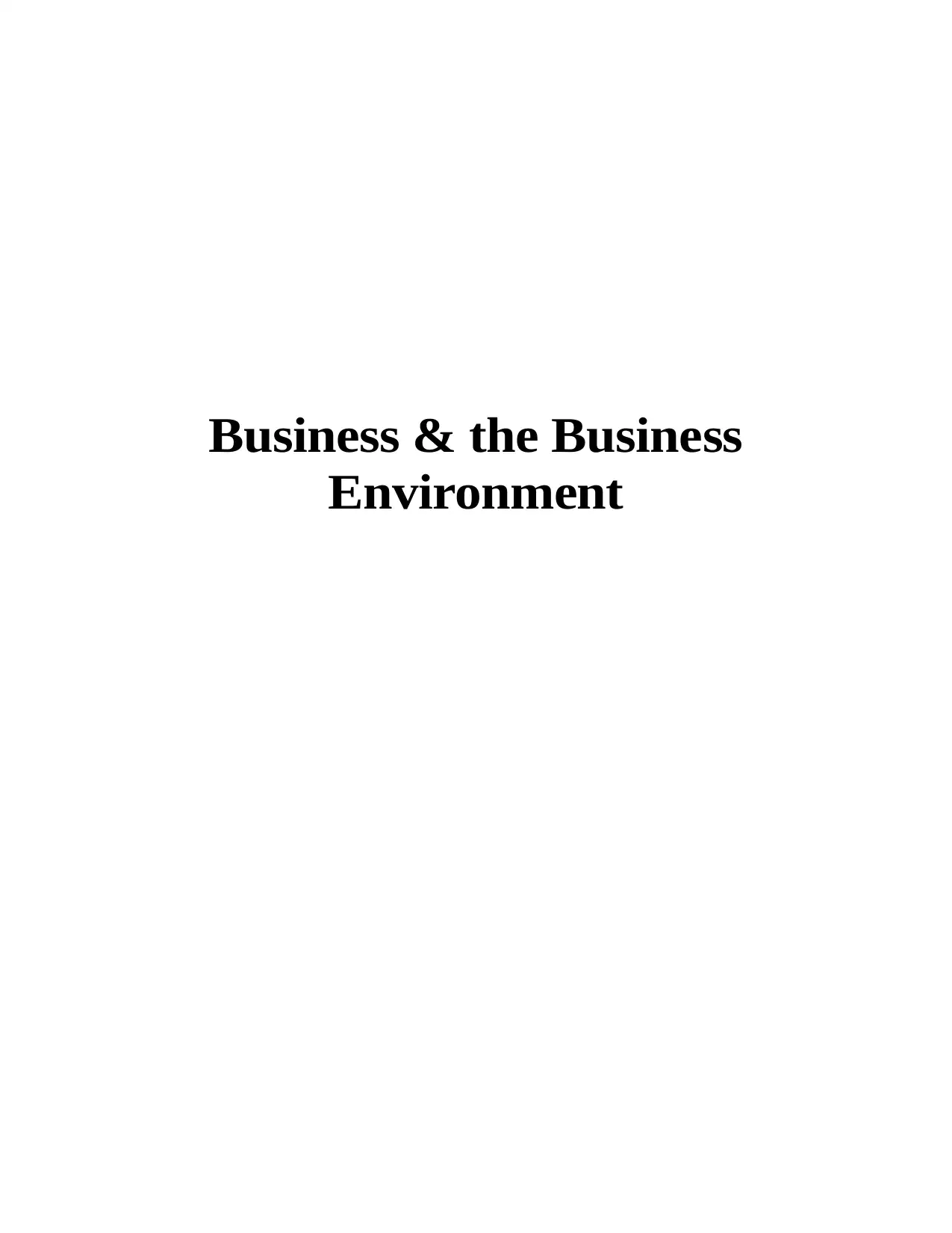
Business & the Business
Environment
Environment
Paraphrase This Document
Need a fresh take? Get an instant paraphrase of this document with our AI Paraphraser

TABLE OF CONTENTS
INTRODUCTION...........................................................................................................................3
LO1 .................................................................................................................................................3
P1 Different types of organization...............................................................................................3
P2 Size and scope of organization...............................................................................................4
LO2..................................................................................................................................................6
P3 various function within organization......................................................................................6
LO3..................................................................................................................................................8
P4 Positive and negative impact of macro environment on company.........................................8
LO4..................................................................................................................................................9
P5 Analysis of internal and external factor of environment........................................................9
P6 Strength and weaknesses of company are related to macro environment............................10
CONCLUSION..............................................................................................................................10
REFERENCES..............................................................................................................................12
INTRODUCTION...........................................................................................................................3
LO1 .................................................................................................................................................3
P1 Different types of organization...............................................................................................3
P2 Size and scope of organization...............................................................................................4
LO2..................................................................................................................................................6
P3 various function within organization......................................................................................6
LO3..................................................................................................................................................8
P4 Positive and negative impact of macro environment on company.........................................8
LO4..................................................................................................................................................9
P5 Analysis of internal and external factor of environment........................................................9
P6 Strength and weaknesses of company are related to macro environment............................10
CONCLUSION..............................................................................................................................10
REFERENCES..............................................................................................................................12
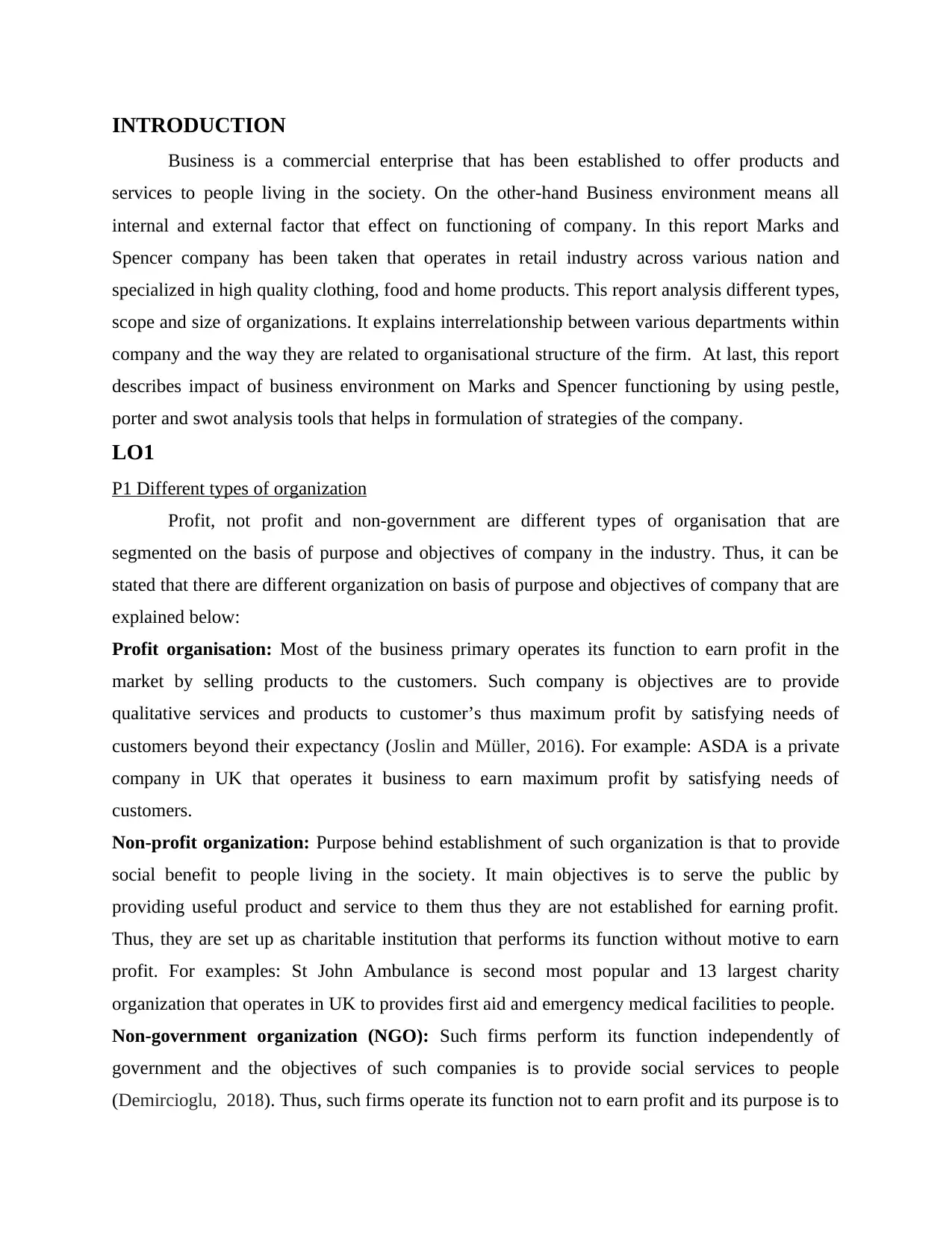
INTRODUCTION
Business is a commercial enterprise that has been established to offer products and
services to people living in the society. On the other-hand Business environment means all
internal and external factor that effect on functioning of company. In this report Marks and
Spencer company has been taken that operates in retail industry across various nation and
specialized in high quality clothing, food and home products. This report analysis different types,
scope and size of organizations. It explains interrelationship between various departments within
company and the way they are related to organisational structure of the firm. At last, this report
describes impact of business environment on Marks and Spencer functioning by using pestle,
porter and swot analysis tools that helps in formulation of strategies of the company.
LO1
P1 Different types of organization
Profit, not profit and non-government are different types of organisation that are
segmented on the basis of purpose and objectives of company in the industry. Thus, it can be
stated that there are different organization on basis of purpose and objectives of company that are
explained below:
Profit organisation: Most of the business primary operates its function to earn profit in the
market by selling products to the customers. Such company is objectives are to provide
qualitative services and products to customer’s thus maximum profit by satisfying needs of
customers beyond their expectancy (Joslin and Müller, 2016). For example: ASDA is a private
company in UK that operates it business to earn maximum profit by satisfying needs of
customers.
Non-profit organization: Purpose behind establishment of such organization is that to provide
social benefit to people living in the society. It main objectives is to serve the public by
providing useful product and service to them thus they are not established for earning profit.
Thus, they are set up as charitable institution that performs its function without motive to earn
profit. For examples: St John Ambulance is second most popular and 13 largest charity
organization that operates in UK to provides first aid and emergency medical facilities to people.
Non-government organization (NGO): Such firms perform its function independently of
government and the objectives of such companies is to provide social services to people
(Demircioglu, 2018). Thus, such firms operate its function not to earn profit and its purpose is to
Business is a commercial enterprise that has been established to offer products and
services to people living in the society. On the other-hand Business environment means all
internal and external factor that effect on functioning of company. In this report Marks and
Spencer company has been taken that operates in retail industry across various nation and
specialized in high quality clothing, food and home products. This report analysis different types,
scope and size of organizations. It explains interrelationship between various departments within
company and the way they are related to organisational structure of the firm. At last, this report
describes impact of business environment on Marks and Spencer functioning by using pestle,
porter and swot analysis tools that helps in formulation of strategies of the company.
LO1
P1 Different types of organization
Profit, not profit and non-government are different types of organisation that are
segmented on the basis of purpose and objectives of company in the industry. Thus, it can be
stated that there are different organization on basis of purpose and objectives of company that are
explained below:
Profit organisation: Most of the business primary operates its function to earn profit in the
market by selling products to the customers. Such company is objectives are to provide
qualitative services and products to customer’s thus maximum profit by satisfying needs of
customers beyond their expectancy (Joslin and Müller, 2016). For example: ASDA is a private
company in UK that operates it business to earn maximum profit by satisfying needs of
customers.
Non-profit organization: Purpose behind establishment of such organization is that to provide
social benefit to people living in the society. It main objectives is to serve the public by
providing useful product and service to them thus they are not established for earning profit.
Thus, they are set up as charitable institution that performs its function without motive to earn
profit. For examples: St John Ambulance is second most popular and 13 largest charity
organization that operates in UK to provides first aid and emergency medical facilities to people.
Non-government organization (NGO): Such firms perform its function independently of
government and the objectives of such companies is to provide social services to people
(Demircioglu, 2018). Thus, such firms operate its function not to earn profit and its purpose is to
⊘ This is a preview!⊘
Do you want full access?
Subscribe today to unlock all pages.

Trusted by 1+ million students worldwide
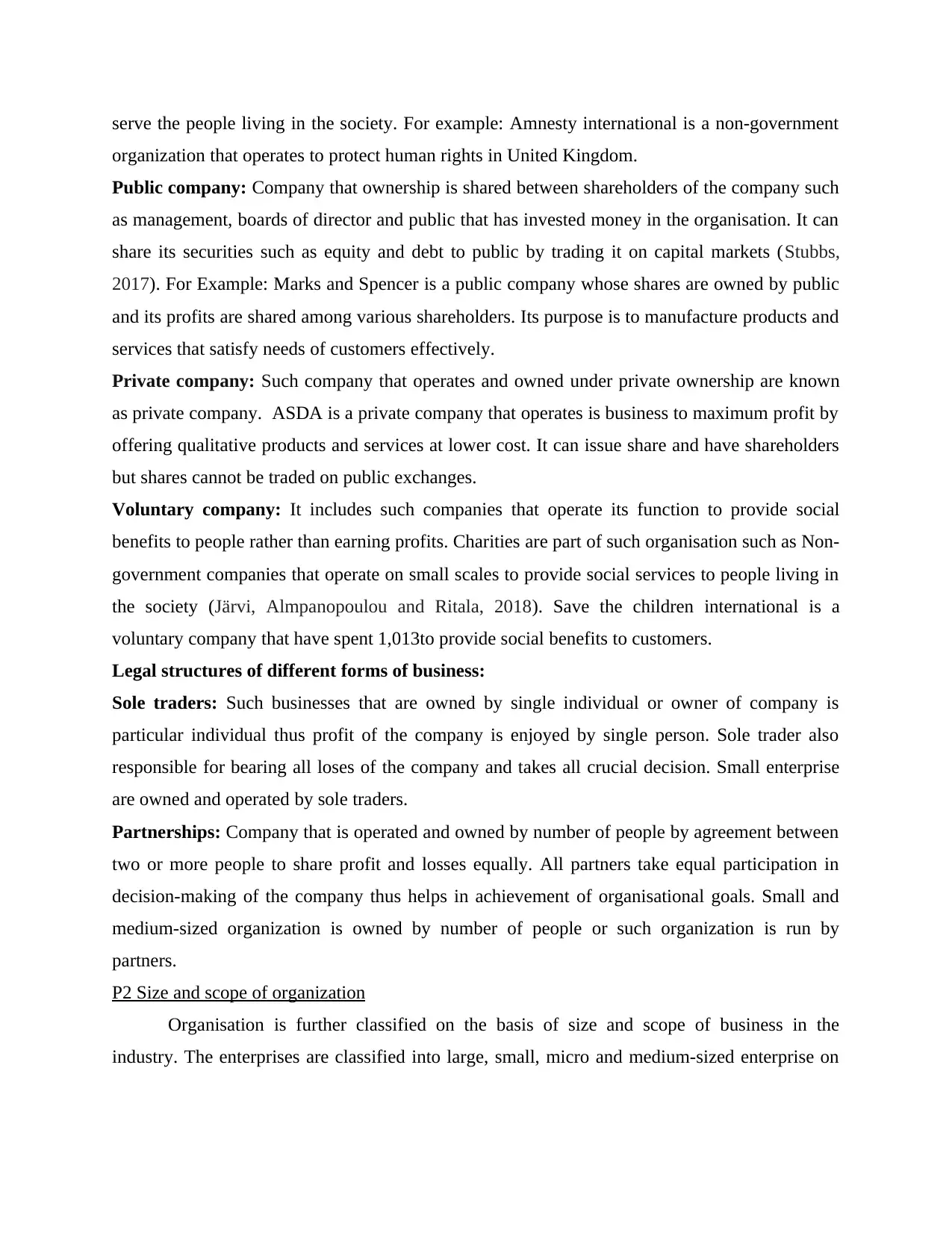
serve the people living in the society. For example: Amnesty international is a non-government
organization that operates to protect human rights in United Kingdom.
Public company: Company that ownership is shared between shareholders of the company such
as management, boards of director and public that has invested money in the organisation. It can
share its securities such as equity and debt to public by trading it on capital markets (Stubbs,
2017). For Example: Marks and Spencer is a public company whose shares are owned by public
and its profits are shared among various shareholders. Its purpose is to manufacture products and
services that satisfy needs of customers effectively.
Private company: Such company that operates and owned under private ownership are known
as private company. ASDA is a private company that operates is business to maximum profit by
offering qualitative products and services at lower cost. It can issue share and have shareholders
but shares cannot be traded on public exchanges.
Voluntary company: It includes such companies that operate its function to provide social
benefits to people rather than earning profits. Charities are part of such organisation such as Non-
government companies that operate on small scales to provide social services to people living in
the society (Järvi, Almpanopoulou and Ritala, 2018). Save the children international is a
voluntary company that have spent 1,013to provide social benefits to customers.
Legal structures of different forms of business:
Sole traders: Such businesses that are owned by single individual or owner of company is
particular individual thus profit of the company is enjoyed by single person. Sole trader also
responsible for bearing all loses of the company and takes all crucial decision. Small enterprise
are owned and operated by sole traders.
Partnerships: Company that is operated and owned by number of people by agreement between
two or more people to share profit and losses equally. All partners take equal participation in
decision-making of the company thus helps in achievement of organisational goals. Small and
medium-sized organization is owned by number of people or such organization is run by
partners.
P2 Size and scope of organization
Organisation is further classified on the basis of size and scope of business in the
industry. The enterprises are classified into large, small, micro and medium-sized enterprise on
organization that operates to protect human rights in United Kingdom.
Public company: Company that ownership is shared between shareholders of the company such
as management, boards of director and public that has invested money in the organisation. It can
share its securities such as equity and debt to public by trading it on capital markets (Stubbs,
2017). For Example: Marks and Spencer is a public company whose shares are owned by public
and its profits are shared among various shareholders. Its purpose is to manufacture products and
services that satisfy needs of customers effectively.
Private company: Such company that operates and owned under private ownership are known
as private company. ASDA is a private company that operates is business to maximum profit by
offering qualitative products and services at lower cost. It can issue share and have shareholders
but shares cannot be traded on public exchanges.
Voluntary company: It includes such companies that operate its function to provide social
benefits to people rather than earning profits. Charities are part of such organisation such as Non-
government companies that operate on small scales to provide social services to people living in
the society (Järvi, Almpanopoulou and Ritala, 2018). Save the children international is a
voluntary company that have spent 1,013to provide social benefits to customers.
Legal structures of different forms of business:
Sole traders: Such businesses that are owned by single individual or owner of company is
particular individual thus profit of the company is enjoyed by single person. Sole trader also
responsible for bearing all loses of the company and takes all crucial decision. Small enterprise
are owned and operated by sole traders.
Partnerships: Company that is operated and owned by number of people by agreement between
two or more people to share profit and losses equally. All partners take equal participation in
decision-making of the company thus helps in achievement of organisational goals. Small and
medium-sized organization is owned by number of people or such organization is run by
partners.
P2 Size and scope of organization
Organisation is further classified on the basis of size and scope of business in the
industry. The enterprises are classified into large, small, micro and medium-sized enterprise on
Paraphrase This Document
Need a fresh take? Get an instant paraphrase of this document with our AI Paraphraser
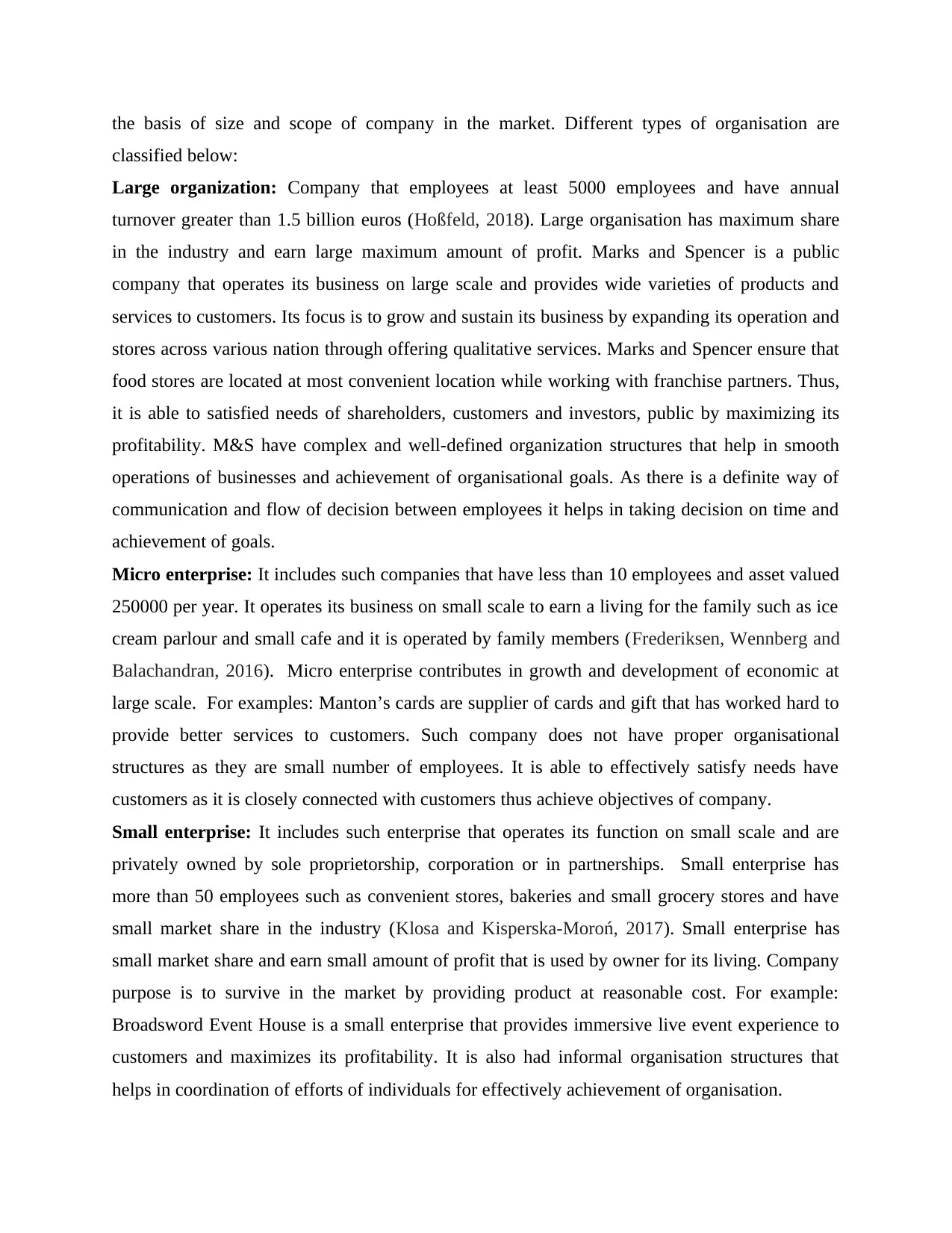
the basis of size and scope of company in the market. Different types of organisation are
classified below:
Large organization: Company that employees at least 5000 employees and have annual
turnover greater than 1.5 billion euros (Hoßfeld, 2018). Large organisation has maximum share
in the industry and earn large maximum amount of profit. Marks and Spencer is a public
company that operates its business on large scale and provides wide varieties of products and
services to customers. Its focus is to grow and sustain its business by expanding its operation and
stores across various nation through offering qualitative services. Marks and Spencer ensure that
food stores are located at most convenient location while working with franchise partners. Thus,
it is able to satisfied needs of shareholders, customers and investors, public by maximizing its
profitability. M&S have complex and well-defined organization structures that help in smooth
operations of businesses and achievement of organisational goals. As there is a definite way of
communication and flow of decision between employees it helps in taking decision on time and
achievement of goals.
Micro enterprise: It includes such companies that have less than 10 employees and asset valued
250000 per year. It operates its business on small scale to earn a living for the family such as ice
cream parlour and small cafe and it is operated by family members (Frederiksen, Wennberg and
Balachandran, 2016). Micro enterprise contributes in growth and development of economic at
large scale. For examples: Manton’s cards are supplier of cards and gift that has worked hard to
provide better services to customers. Such company does not have proper organisational
structures as they are small number of employees. It is able to effectively satisfy needs have
customers as it is closely connected with customers thus achieve objectives of company.
Small enterprise: It includes such enterprise that operates its function on small scale and are
privately owned by sole proprietorship, corporation or in partnerships. Small enterprise has
more than 50 employees such as convenient stores, bakeries and small grocery stores and have
small market share in the industry (Klosa and Kisperska-Moroń, 2017). Small enterprise has
small market share and earn small amount of profit that is used by owner for its living. Company
purpose is to survive in the market by providing product at reasonable cost. For example:
Broadsword Event House is a small enterprise that provides immersive live event experience to
customers and maximizes its profitability. It is also had informal organisation structures that
helps in coordination of efforts of individuals for effectively achievement of organisation.
classified below:
Large organization: Company that employees at least 5000 employees and have annual
turnover greater than 1.5 billion euros (Hoßfeld, 2018). Large organisation has maximum share
in the industry and earn large maximum amount of profit. Marks and Spencer is a public
company that operates its business on large scale and provides wide varieties of products and
services to customers. Its focus is to grow and sustain its business by expanding its operation and
stores across various nation through offering qualitative services. Marks and Spencer ensure that
food stores are located at most convenient location while working with franchise partners. Thus,
it is able to satisfied needs of shareholders, customers and investors, public by maximizing its
profitability. M&S have complex and well-defined organization structures that help in smooth
operations of businesses and achievement of organisational goals. As there is a definite way of
communication and flow of decision between employees it helps in taking decision on time and
achievement of goals.
Micro enterprise: It includes such companies that have less than 10 employees and asset valued
250000 per year. It operates its business on small scale to earn a living for the family such as ice
cream parlour and small cafe and it is operated by family members (Frederiksen, Wennberg and
Balachandran, 2016). Micro enterprise contributes in growth and development of economic at
large scale. For examples: Manton’s cards are supplier of cards and gift that has worked hard to
provide better services to customers. Such company does not have proper organisational
structures as they are small number of employees. It is able to effectively satisfy needs have
customers as it is closely connected with customers thus achieve objectives of company.
Small enterprise: It includes such enterprise that operates its function on small scale and are
privately owned by sole proprietorship, corporation or in partnerships. Small enterprise has
more than 50 employees such as convenient stores, bakeries and small grocery stores and have
small market share in the industry (Klosa and Kisperska-Moroń, 2017). Small enterprise has
small market share and earn small amount of profit that is used by owner for its living. Company
purpose is to survive in the market by providing product at reasonable cost. For example:
Broadsword Event House is a small enterprise that provides immersive live event experience to
customers and maximizes its profitability. It is also had informal organisation structures that
helps in coordination of efforts of individuals for effectively achievement of organisation.

Medium-sized enterprise: Companies hires more than 250 employees and it represents 99% of
all businesses in European Union and employee large number of people. Medium-sized
enterprise helps in bringing innovation and competition in the country thus there focus is to grow
in the market (Yildirim and Özen, 2018). For example: ASDA is a medium-sized enterprise that
is operating its business in retail industry providing products and services at reasonable rates to
attract large number of customers. Thus, company by offering product and services at reasonable
cost is able to expand its profitability and market share. It is planning to expand and grow in
market and possessing threat from other companies such as Marks and Spencer as it provide
quality product at reasonable cost. It has functional organization structures that means structures
of company is divided on the basis of function performed by each department. It helps in
effectively coordinate and achievement of company mission and vision as each function is
performed by specialised departments such as marketing, production.
Complexities of transnational, international and global structures
International companies have formal organisation structures that help in achievement of
company vision and mission by assigning definite roles and responsibilities to each individuals
(Gowreesunkar, Séraphin and Morrison, 2018). Whereas transnational companies have complex
organisational structure it has invested in foreign operations but central corporate facility thus it
has functional organisational structures that help in coordinate of various department across
nation. On the other hand global companies have invested money in many countries so it follows
geographical structures for smooth operations of business and achievement of goals and vision of
company.
LO2
P3 various function within organization
Various roles are played by different departments such as marketing, human resource and
finance in operations and achievement of organisational goals. Different departments of Marks
and Spencer and there interrelationship helps in sustainability and growth of business is
explained below:
Marketing departments: It is responsible for gathering information about market trends and
taste and preference of people living in the society thus assist production departments to
manufacture as per needs of customers (Kulapov and et.al., 2019). It is most crucial department
as it influences customers to make purchase products and services of Marks and Spencer.
all businesses in European Union and employee large number of people. Medium-sized
enterprise helps in bringing innovation and competition in the country thus there focus is to grow
in the market (Yildirim and Özen, 2018). For example: ASDA is a medium-sized enterprise that
is operating its business in retail industry providing products and services at reasonable rates to
attract large number of customers. Thus, company by offering product and services at reasonable
cost is able to expand its profitability and market share. It is planning to expand and grow in
market and possessing threat from other companies such as Marks and Spencer as it provide
quality product at reasonable cost. It has functional organization structures that means structures
of company is divided on the basis of function performed by each department. It helps in
effectively coordinate and achievement of company mission and vision as each function is
performed by specialised departments such as marketing, production.
Complexities of transnational, international and global structures
International companies have formal organisation structures that help in achievement of
company vision and mission by assigning definite roles and responsibilities to each individuals
(Gowreesunkar, Séraphin and Morrison, 2018). Whereas transnational companies have complex
organisational structure it has invested in foreign operations but central corporate facility thus it
has functional organisational structures that help in coordinate of various department across
nation. On the other hand global companies have invested money in many countries so it follows
geographical structures for smooth operations of business and achievement of goals and vision of
company.
LO2
P3 various function within organization
Various roles are played by different departments such as marketing, human resource and
finance in operations and achievement of organisational goals. Different departments of Marks
and Spencer and there interrelationship helps in sustainability and growth of business is
explained below:
Marketing departments: It is responsible for gathering information about market trends and
taste and preference of people living in the society thus assist production departments to
manufacture as per needs of customers (Kulapov and et.al., 2019). It is most crucial department
as it influences customers to make purchase products and services of Marks and Spencer.
⊘ This is a preview!⊘
Do you want full access?
Subscribe today to unlock all pages.

Trusted by 1+ million students worldwide
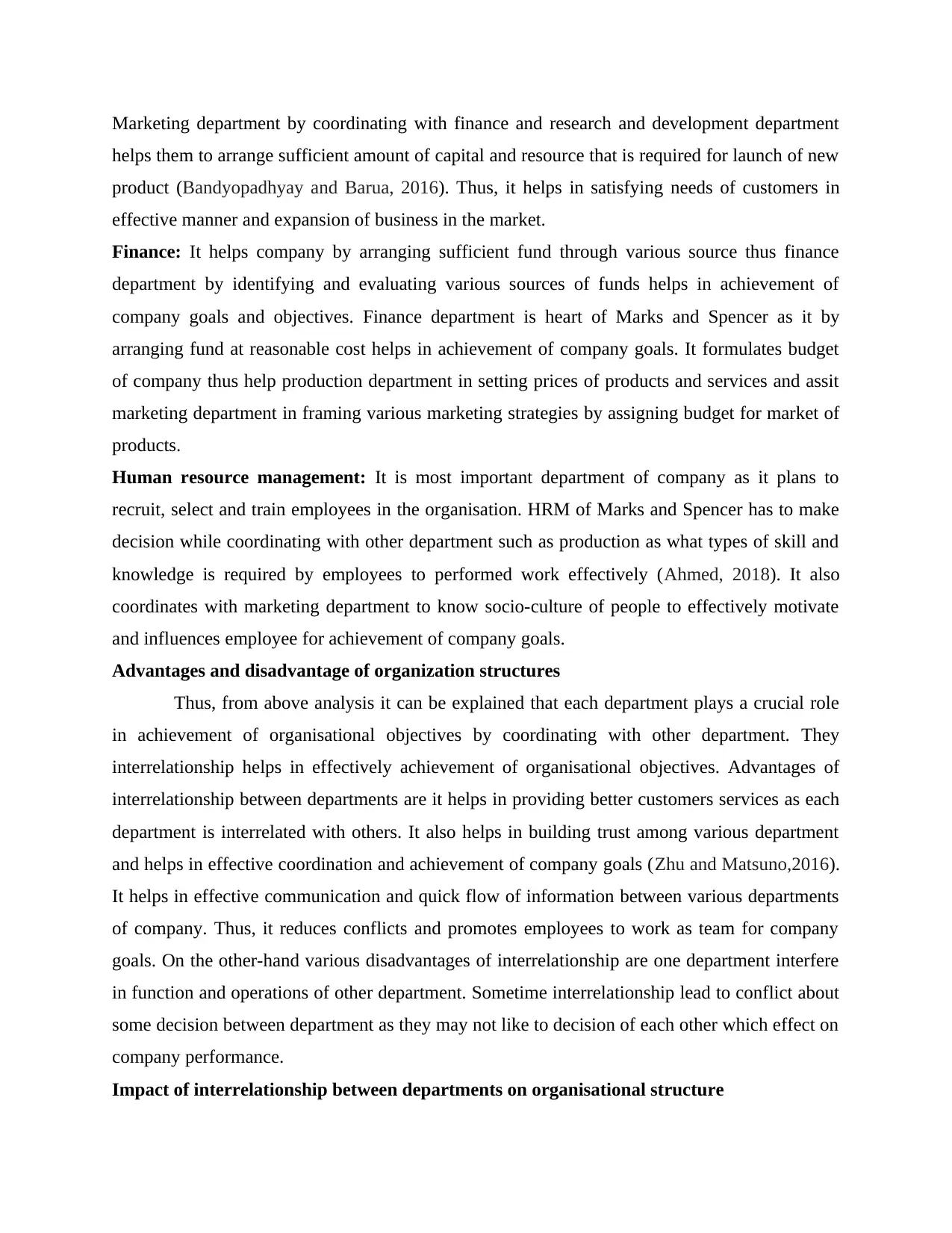
Marketing department by coordinating with finance and research and development department
helps them to arrange sufficient amount of capital and resource that is required for launch of new
product (Bandyopadhyay and Barua, 2016). Thus, it helps in satisfying needs of customers in
effective manner and expansion of business in the market.
Finance: It helps company by arranging sufficient fund through various source thus finance
department by identifying and evaluating various sources of funds helps in achievement of
company goals and objectives. Finance department is heart of Marks and Spencer as it by
arranging fund at reasonable cost helps in achievement of company goals. It formulates budget
of company thus help production department in setting prices of products and services and assit
marketing department in framing various marketing strategies by assigning budget for market of
products.
Human resource management: It is most important department of company as it plans to
recruit, select and train employees in the organisation. HRM of Marks and Spencer has to make
decision while coordinating with other department such as production as what types of skill and
knowledge is required by employees to performed work effectively (Ahmed, 2018). It also
coordinates with marketing department to know socio-culture of people to effectively motivate
and influences employee for achievement of company goals.
Advantages and disadvantage of organization structures
Thus, from above analysis it can be explained that each department plays a crucial role
in achievement of organisational objectives by coordinating with other department. They
interrelationship helps in effectively achievement of organisational objectives. Advantages of
interrelationship between departments are it helps in providing better customers services as each
department is interrelated with others. It also helps in building trust among various department
and helps in effective coordination and achievement of company goals (Zhu and Matsuno,2016).
It helps in effective communication and quick flow of information between various departments
of company. Thus, it reduces conflicts and promotes employees to work as team for company
goals. On the other-hand various disadvantages of interrelationship are one department interfere
in function and operations of other department. Sometime interrelationship lead to conflict about
some decision between department as they may not like to decision of each other which effect on
company performance.
Impact of interrelationship between departments on organisational structure
helps them to arrange sufficient amount of capital and resource that is required for launch of new
product (Bandyopadhyay and Barua, 2016). Thus, it helps in satisfying needs of customers in
effective manner and expansion of business in the market.
Finance: It helps company by arranging sufficient fund through various source thus finance
department by identifying and evaluating various sources of funds helps in achievement of
company goals and objectives. Finance department is heart of Marks and Spencer as it by
arranging fund at reasonable cost helps in achievement of company goals. It formulates budget
of company thus help production department in setting prices of products and services and assit
marketing department in framing various marketing strategies by assigning budget for market of
products.
Human resource management: It is most important department of company as it plans to
recruit, select and train employees in the organisation. HRM of Marks and Spencer has to make
decision while coordinating with other department such as production as what types of skill and
knowledge is required by employees to performed work effectively (Ahmed, 2018). It also
coordinates with marketing department to know socio-culture of people to effectively motivate
and influences employee for achievement of company goals.
Advantages and disadvantage of organization structures
Thus, from above analysis it can be explained that each department plays a crucial role
in achievement of organisational objectives by coordinating with other department. They
interrelationship helps in effectively achievement of organisational objectives. Advantages of
interrelationship between departments are it helps in providing better customers services as each
department is interrelated with others. It also helps in building trust among various department
and helps in effective coordination and achievement of company goals (Zhu and Matsuno,2016).
It helps in effective communication and quick flow of information between various departments
of company. Thus, it reduces conflicts and promotes employees to work as team for company
goals. On the other-hand various disadvantages of interrelationship are one department interfere
in function and operations of other department. Sometime interrelationship lead to conflict about
some decision between department as they may not like to decision of each other which effect on
company performance.
Impact of interrelationship between departments on organisational structure
Paraphrase This Document
Need a fresh take? Get an instant paraphrase of this document with our AI Paraphraser
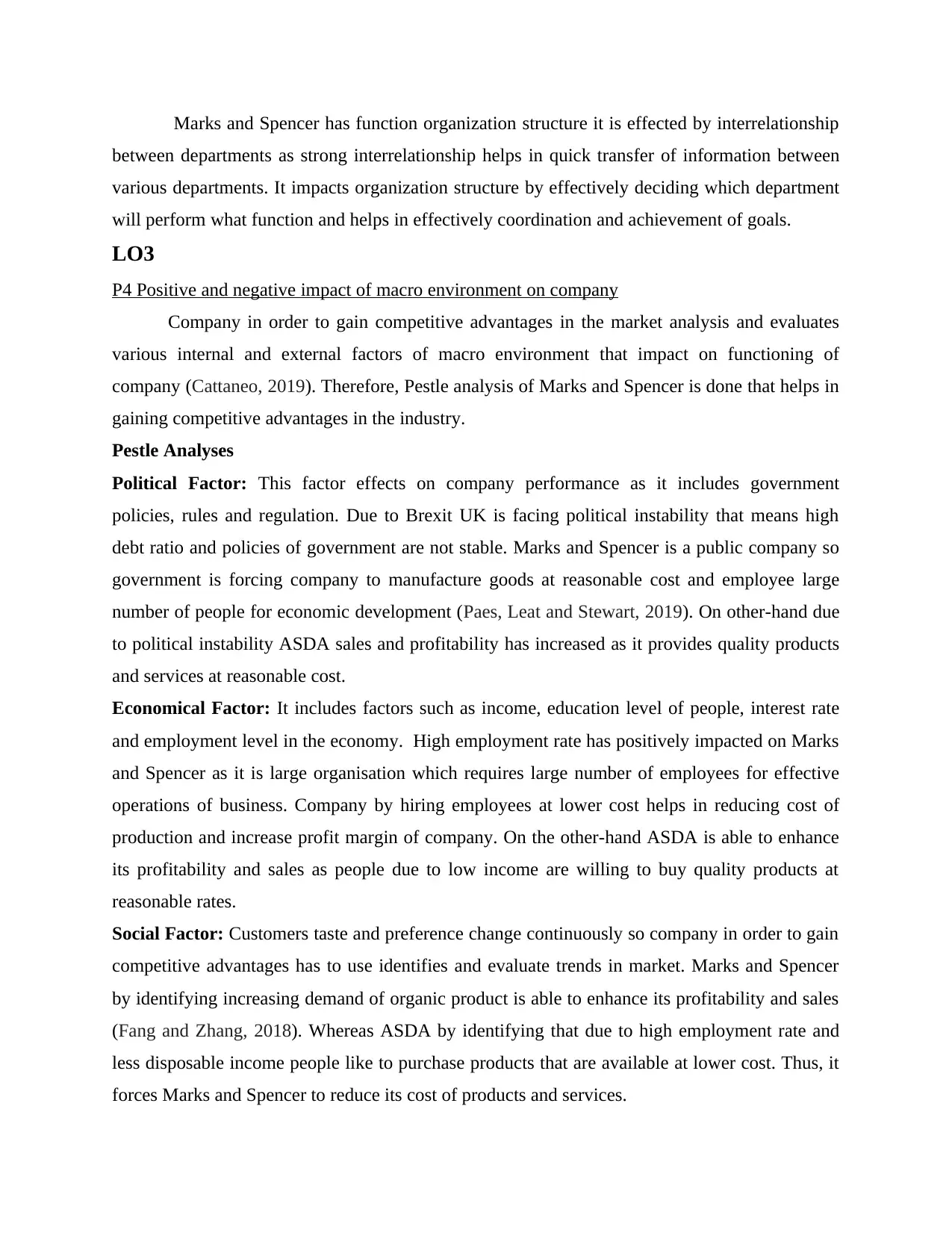
Marks and Spencer has function organization structure it is effected by interrelationship
between departments as strong interrelationship helps in quick transfer of information between
various departments. It impacts organization structure by effectively deciding which department
will perform what function and helps in effectively coordination and achievement of goals.
LO3
P4 Positive and negative impact of macro environment on company
Company in order to gain competitive advantages in the market analysis and evaluates
various internal and external factors of macro environment that impact on functioning of
company (Cattaneo, 2019). Therefore, Pestle analysis of Marks and Spencer is done that helps in
gaining competitive advantages in the industry.
Pestle Analyses
Political Factor: This factor effects on company performance as it includes government
policies, rules and regulation. Due to Brexit UK is facing political instability that means high
debt ratio and policies of government are not stable. Marks and Spencer is a public company so
government is forcing company to manufacture goods at reasonable cost and employee large
number of people for economic development (Paes, Leat and Stewart, 2019). On other-hand due
to political instability ASDA sales and profitability has increased as it provides quality products
and services at reasonable cost.
Economical Factor: It includes factors such as income, education level of people, interest rate
and employment level in the economy. High employment rate has positively impacted on Marks
and Spencer as it is large organisation which requires large number of employees for effective
operations of business. Company by hiring employees at lower cost helps in reducing cost of
production and increase profit margin of company. On the other-hand ASDA is able to enhance
its profitability and sales as people due to low income are willing to buy quality products at
reasonable rates.
Social Factor: Customers taste and preference change continuously so company in order to gain
competitive advantages has to use identifies and evaluate trends in market. Marks and Spencer
by identifying increasing demand of organic product is able to enhance its profitability and sales
(Fang and Zhang, 2018). Whereas ASDA by identifying that due to high employment rate and
less disposable income people like to purchase products that are available at lower cost. Thus, it
forces Marks and Spencer to reduce its cost of products and services.
between departments as strong interrelationship helps in quick transfer of information between
various departments. It impacts organization structure by effectively deciding which department
will perform what function and helps in effectively coordination and achievement of goals.
LO3
P4 Positive and negative impact of macro environment on company
Company in order to gain competitive advantages in the market analysis and evaluates
various internal and external factors of macro environment that impact on functioning of
company (Cattaneo, 2019). Therefore, Pestle analysis of Marks and Spencer is done that helps in
gaining competitive advantages in the industry.
Pestle Analyses
Political Factor: This factor effects on company performance as it includes government
policies, rules and regulation. Due to Brexit UK is facing political instability that means high
debt ratio and policies of government are not stable. Marks and Spencer is a public company so
government is forcing company to manufacture goods at reasonable cost and employee large
number of people for economic development (Paes, Leat and Stewart, 2019). On other-hand due
to political instability ASDA sales and profitability has increased as it provides quality products
and services at reasonable cost.
Economical Factor: It includes factors such as income, education level of people, interest rate
and employment level in the economy. High employment rate has positively impacted on Marks
and Spencer as it is large organisation which requires large number of employees for effective
operations of business. Company by hiring employees at lower cost helps in reducing cost of
production and increase profit margin of company. On the other-hand ASDA is able to enhance
its profitability and sales as people due to low income are willing to buy quality products at
reasonable rates.
Social Factor: Customers taste and preference change continuously so company in order to gain
competitive advantages has to use identifies and evaluate trends in market. Marks and Spencer
by identifying increasing demand of organic product is able to enhance its profitability and sales
(Fang and Zhang, 2018). Whereas ASDA by identifying that due to high employment rate and
less disposable income people like to purchase products that are available at lower cost. Thus, it
forces Marks and Spencer to reduce its cost of products and services.
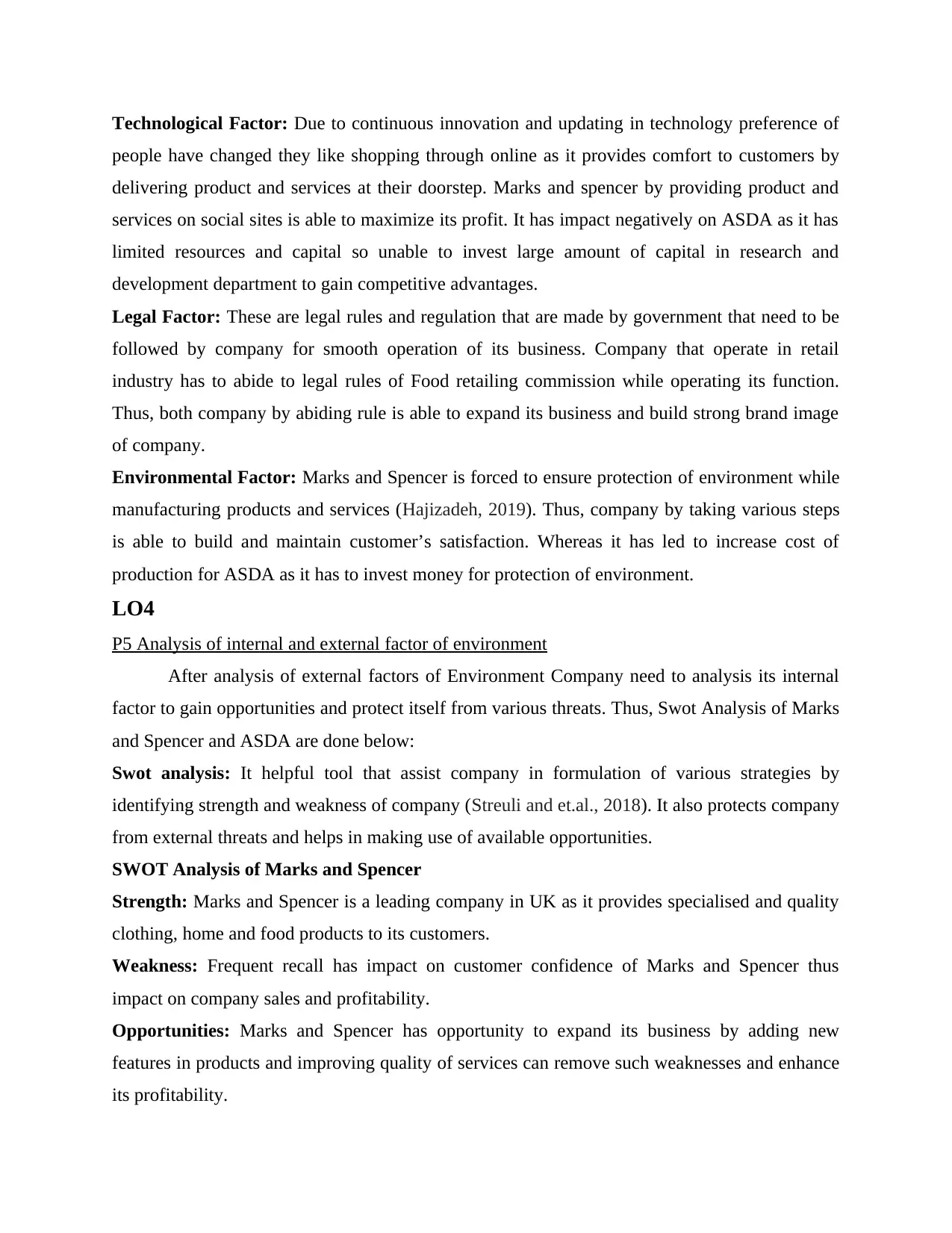
Technological Factor: Due to continuous innovation and updating in technology preference of
people have changed they like shopping through online as it provides comfort to customers by
delivering product and services at their doorstep. Marks and spencer by providing product and
services on social sites is able to maximize its profit. It has impact negatively on ASDA as it has
limited resources and capital so unable to invest large amount of capital in research and
development department to gain competitive advantages.
Legal Factor: These are legal rules and regulation that are made by government that need to be
followed by company for smooth operation of its business. Company that operate in retail
industry has to abide to legal rules of Food retailing commission while operating its function.
Thus, both company by abiding rule is able to expand its business and build strong brand image
of company.
Environmental Factor: Marks and Spencer is forced to ensure protection of environment while
manufacturing products and services (Hajizadeh, 2019). Thus, company by taking various steps
is able to build and maintain customer’s satisfaction. Whereas it has led to increase cost of
production for ASDA as it has to invest money for protection of environment.
LO4
P5 Analysis of internal and external factor of environment
After analysis of external factors of Environment Company need to analysis its internal
factor to gain opportunities and protect itself from various threats. Thus, Swot Analysis of Marks
and Spencer and ASDA are done below:
Swot analysis: It helpful tool that assist company in formulation of various strategies by
identifying strength and weakness of company (Streuli and et.al., 2018). It also protects company
from external threats and helps in making use of available opportunities.
SWOT Analysis of Marks and Spencer
Strength: Marks and Spencer is a leading company in UK as it provides specialised and quality
clothing, home and food products to its customers.
Weakness: Frequent recall has impact on customer confidence of Marks and Spencer thus
impact on company sales and profitability.
Opportunities: Marks and Spencer has opportunity to expand its business by adding new
features in products and improving quality of services can remove such weaknesses and enhance
its profitability.
people have changed they like shopping through online as it provides comfort to customers by
delivering product and services at their doorstep. Marks and spencer by providing product and
services on social sites is able to maximize its profit. It has impact negatively on ASDA as it has
limited resources and capital so unable to invest large amount of capital in research and
development department to gain competitive advantages.
Legal Factor: These are legal rules and regulation that are made by government that need to be
followed by company for smooth operation of its business. Company that operate in retail
industry has to abide to legal rules of Food retailing commission while operating its function.
Thus, both company by abiding rule is able to expand its business and build strong brand image
of company.
Environmental Factor: Marks and Spencer is forced to ensure protection of environment while
manufacturing products and services (Hajizadeh, 2019). Thus, company by taking various steps
is able to build and maintain customer’s satisfaction. Whereas it has led to increase cost of
production for ASDA as it has to invest money for protection of environment.
LO4
P5 Analysis of internal and external factor of environment
After analysis of external factors of Environment Company need to analysis its internal
factor to gain opportunities and protect itself from various threats. Thus, Swot Analysis of Marks
and Spencer and ASDA are done below:
Swot analysis: It helpful tool that assist company in formulation of various strategies by
identifying strength and weakness of company (Streuli and et.al., 2018). It also protects company
from external threats and helps in making use of available opportunities.
SWOT Analysis of Marks and Spencer
Strength: Marks and Spencer is a leading company in UK as it provides specialised and quality
clothing, home and food products to its customers.
Weakness: Frequent recall has impact on customer confidence of Marks and Spencer thus
impact on company sales and profitability.
Opportunities: Marks and Spencer has opportunity to expand its business by adding new
features in products and improving quality of services can remove such weaknesses and enhance
its profitability.
⊘ This is a preview!⊘
Do you want full access?
Subscribe today to unlock all pages.

Trusted by 1+ million students worldwide

Threats: ASDA by providing qualitative services and products at reasonable rates proves to be
threat for Marks and Spencer. Both ASDA and ADLI by providing products and services are
able to expand and grow its business in the industry.
SWOT Analysis of ASDA
Strength: Whereas ASDA strength lies in its marketing strategies as in order to promote product
it sales them at lower cost thus helps in achievement of goals.
Weakness: ASDA is medium-sized enterprise thus have less resource and concentrate
operations in UK thus less market share and profitability.
Opportunities: ASDA has opportunities to expand its business in UK and other countries and it
can also increase its sales by offering product online.
Threats: ASDA also have to face competition from Marks and Spencer as it is large
organization with number of employees.
P6 Strength and weaknesses of company are related to macro environment
Internal factors such as strength and weaknesses of company helps in gaining
competitive advantages in the market and are related to macro environmental factors. Marks and
Spencer strength lies in qualitative clothing, home and food products so company by identifying
increase demand of organic food able to satisfy needs of customers and expands its business
(Khoshbakht, Gou and Dupre, 2017). ASDA on the other-hand by considering economic factor is
able to influence customers to make purchase by providing qualitative products and services at
reasonable cost. Increasing use of social sites has forced company to use social media to market
its products and services effectively as it attract large number of customers within limited time
and cost. Thus, technological factor helps in gaining opportunities in the market. Economic
condition of country force ASDA and Marks and Spencer to expand its business across various
nation thus it helps in gaining opportunities that is available in the market. Therefore, it can be
stated that internal factors are related to macro environment.
CONCLUSION
From the above report it can be concluded that there are different types of organisation on
the basis of size and scope of the company. The purpose and objectives of company also helps in
segmentation of company into private, public and voluntary. It can also be explained that
interrelationship between various departments have positive and negative impact on organisation
function and structures. It can also be stated that macro environment effect positively and
threat for Marks and Spencer. Both ASDA and ADLI by providing products and services are
able to expand and grow its business in the industry.
SWOT Analysis of ASDA
Strength: Whereas ASDA strength lies in its marketing strategies as in order to promote product
it sales them at lower cost thus helps in achievement of goals.
Weakness: ASDA is medium-sized enterprise thus have less resource and concentrate
operations in UK thus less market share and profitability.
Opportunities: ASDA has opportunities to expand its business in UK and other countries and it
can also increase its sales by offering product online.
Threats: ASDA also have to face competition from Marks and Spencer as it is large
organization with number of employees.
P6 Strength and weaknesses of company are related to macro environment
Internal factors such as strength and weaknesses of company helps in gaining
competitive advantages in the market and are related to macro environmental factors. Marks and
Spencer strength lies in qualitative clothing, home and food products so company by identifying
increase demand of organic food able to satisfy needs of customers and expands its business
(Khoshbakht, Gou and Dupre, 2017). ASDA on the other-hand by considering economic factor is
able to influence customers to make purchase by providing qualitative products and services at
reasonable cost. Increasing use of social sites has forced company to use social media to market
its products and services effectively as it attract large number of customers within limited time
and cost. Thus, technological factor helps in gaining opportunities in the market. Economic
condition of country force ASDA and Marks and Spencer to expand its business across various
nation thus it helps in gaining opportunities that is available in the market. Therefore, it can be
stated that internal factors are related to macro environment.
CONCLUSION
From the above report it can be concluded that there are different types of organisation on
the basis of size and scope of the company. The purpose and objectives of company also helps in
segmentation of company into private, public and voluntary. It can also be explained that
interrelationship between various departments have positive and negative impact on organisation
function and structures. It can also be stated that macro environment effect positively and
Paraphrase This Document
Need a fresh take? Get an instant paraphrase of this document with our AI Paraphraser
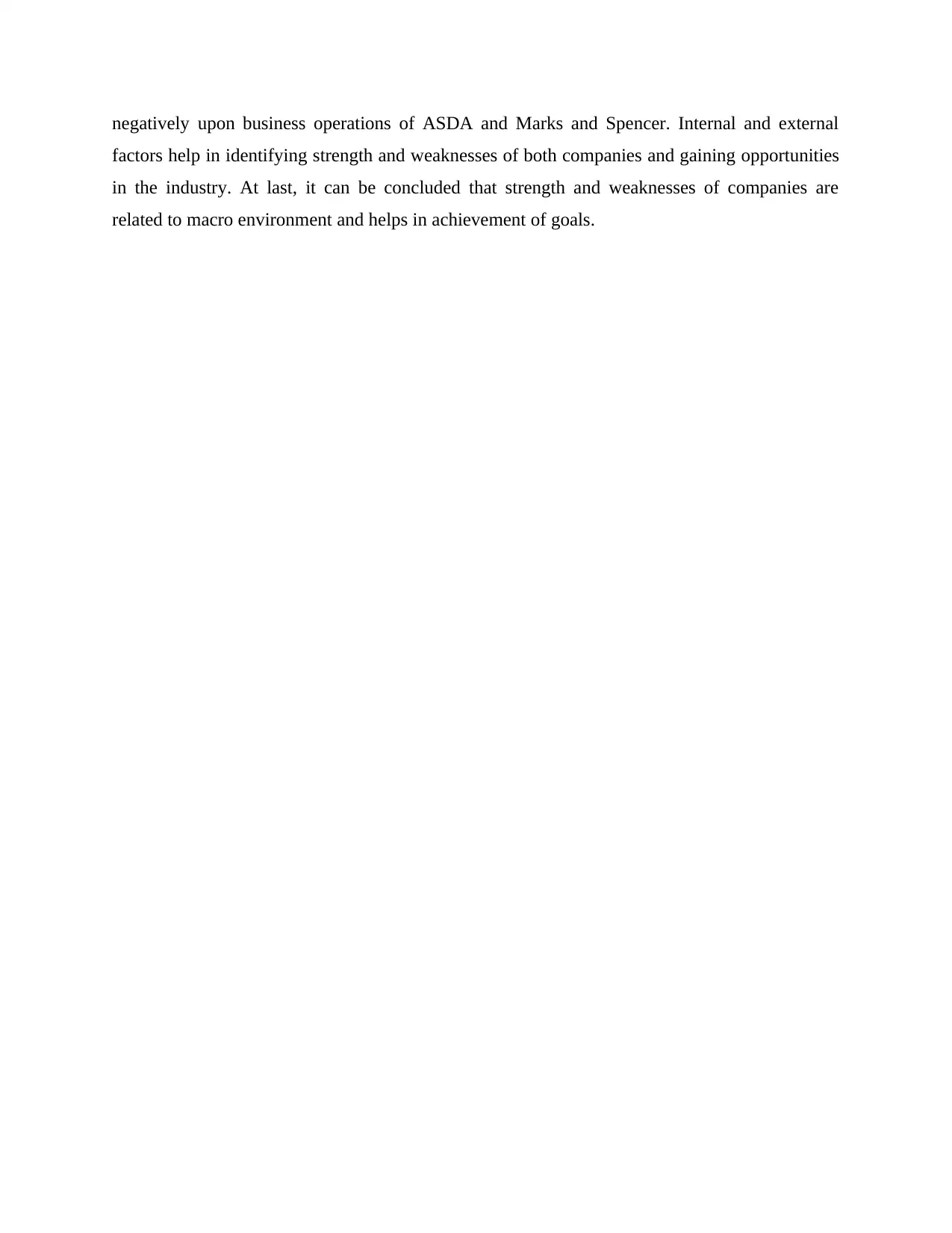
negatively upon business operations of ASDA and Marks and Spencer. Internal and external
factors help in identifying strength and weaknesses of both companies and gaining opportunities
in the industry. At last, it can be concluded that strength and weaknesses of companies are
related to macro environment and helps in achievement of goals.
factors help in identifying strength and weaknesses of both companies and gaining opportunities
in the industry. At last, it can be concluded that strength and weaknesses of companies are
related to macro environment and helps in achievement of goals.
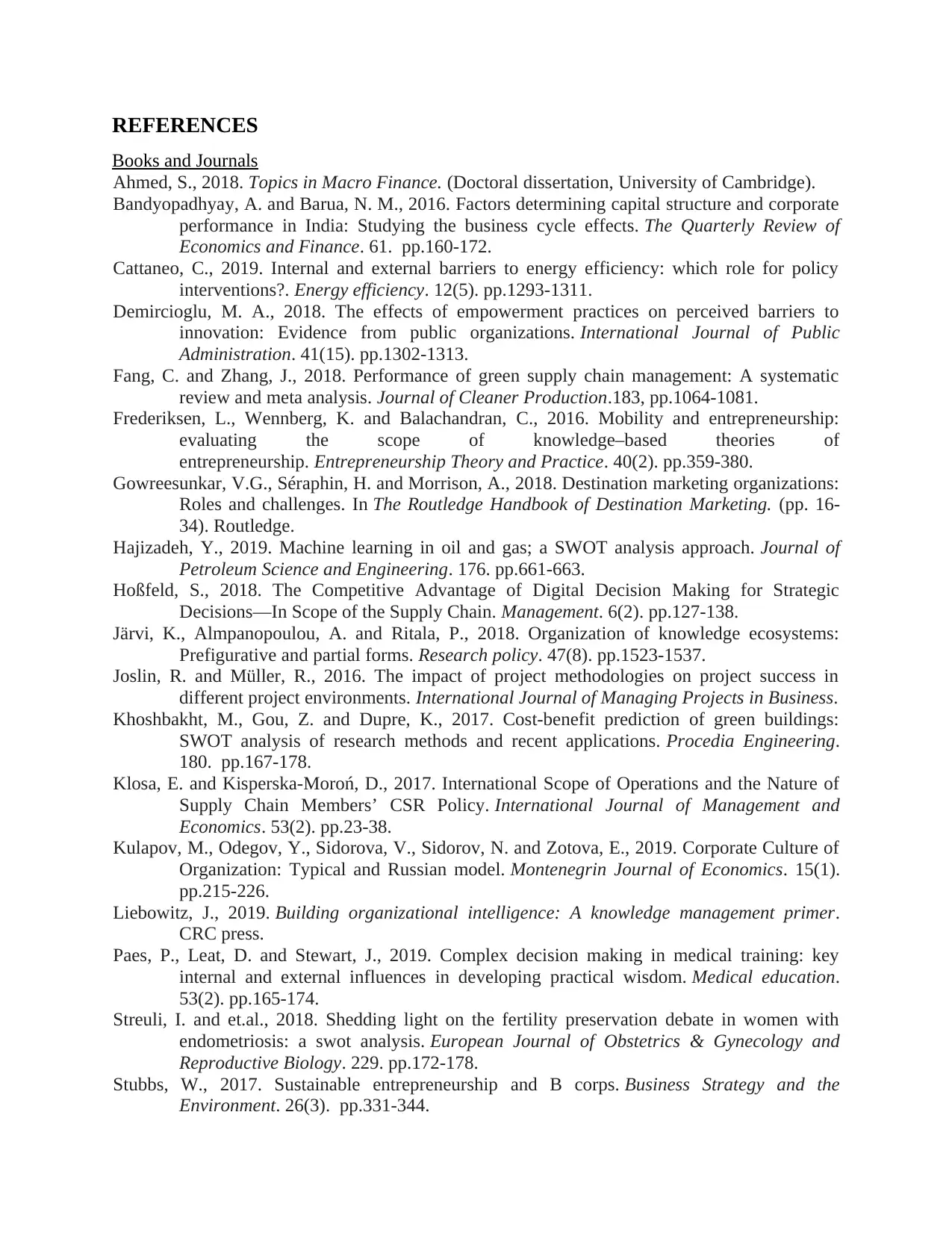
REFERENCES
Books and Journals
Ahmed, S., 2018. Topics in Macro Finance. (Doctoral dissertation, University of Cambridge).
Bandyopadhyay, A. and Barua, N. M., 2016. Factors determining capital structure and corporate
performance in India: Studying the business cycle effects. The Quarterly Review of
Economics and Finance. 61. pp.160-172.
Cattaneo, C., 2019. Internal and external barriers to energy efficiency: which role for policy
interventions?. Energy efficiency. 12(5). pp.1293-1311.
Demircioglu, M. A., 2018. The effects of empowerment practices on perceived barriers to
innovation: Evidence from public organizations. International Journal of Public
Administration. 41(15). pp.1302-1313.
Fang, C. and Zhang, J., 2018. Performance of green supply chain management: A systematic
review and meta analysis. Journal of Cleaner Production.183, pp.1064-1081.
Frederiksen, L., Wennberg, K. and Balachandran, C., 2016. Mobility and entrepreneurship:
evaluating the scope of knowledge–based theories of
entrepreneurship. Entrepreneurship Theory and Practice. 40(2). pp.359-380.
Gowreesunkar, V.G., Séraphin, H. and Morrison, A., 2018. Destination marketing organizations:
Roles and challenges. In The Routledge Handbook of Destination Marketing. (pp. 16-
34). Routledge.
Hajizadeh, Y., 2019. Machine learning in oil and gas; a SWOT analysis approach. Journal of
Petroleum Science and Engineering. 176. pp.661-663.
Hoßfeld, S., 2018. The Competitive Advantage of Digital Decision Making for Strategic
Decisions—In Scope of the Supply Chain. Management. 6(2). pp.127-138.
Järvi, K., Almpanopoulou, A. and Ritala, P., 2018. Organization of knowledge ecosystems:
Prefigurative and partial forms. Research policy. 47(8). pp.1523-1537.
Joslin, R. and Müller, R., 2016. The impact of project methodologies on project success in
different project environments. International Journal of Managing Projects in Business.
Khoshbakht, M., Gou, Z. and Dupre, K., 2017. Cost-benefit prediction of green buildings:
SWOT analysis of research methods and recent applications. Procedia Engineering.
180. pp.167-178.
Klosa, E. and Kisperska-Moroń, D., 2017. International Scope of Operations and the Nature of
Supply Chain Members’ CSR Policy. International Journal of Management and
Economics. 53(2). pp.23-38.
Kulapov, M., Odegov, Y., Sidorova, V., Sidorov, N. and Zotova, E., 2019. Corporate Culture of
Organization: Typical and Russian model. Montenegrin Journal of Economics. 15(1).
pp.215-226.
Liebowitz, J., 2019. Building organizational intelligence: A knowledge management primer.
CRC press.
Paes, P., Leat, D. and Stewart, J., 2019. Complex decision making in medical training: key
internal and external influences in developing practical wisdom. Medical education.
53(2). pp.165-174.
Streuli, I. and et.al., 2018. Shedding light on the fertility preservation debate in women with
endometriosis: a swot analysis. European Journal of Obstetrics & Gynecology and
Reproductive Biology. 229. pp.172-178.
Stubbs, W., 2017. Sustainable entrepreneurship and B corps. Business Strategy and the
Environment. 26(3). pp.331-344.
Books and Journals
Ahmed, S., 2018. Topics in Macro Finance. (Doctoral dissertation, University of Cambridge).
Bandyopadhyay, A. and Barua, N. M., 2016. Factors determining capital structure and corporate
performance in India: Studying the business cycle effects. The Quarterly Review of
Economics and Finance. 61. pp.160-172.
Cattaneo, C., 2019. Internal and external barriers to energy efficiency: which role for policy
interventions?. Energy efficiency. 12(5). pp.1293-1311.
Demircioglu, M. A., 2018. The effects of empowerment practices on perceived barriers to
innovation: Evidence from public organizations. International Journal of Public
Administration. 41(15). pp.1302-1313.
Fang, C. and Zhang, J., 2018. Performance of green supply chain management: A systematic
review and meta analysis. Journal of Cleaner Production.183, pp.1064-1081.
Frederiksen, L., Wennberg, K. and Balachandran, C., 2016. Mobility and entrepreneurship:
evaluating the scope of knowledge–based theories of
entrepreneurship. Entrepreneurship Theory and Practice. 40(2). pp.359-380.
Gowreesunkar, V.G., Séraphin, H. and Morrison, A., 2018. Destination marketing organizations:
Roles and challenges. In The Routledge Handbook of Destination Marketing. (pp. 16-
34). Routledge.
Hajizadeh, Y., 2019. Machine learning in oil and gas; a SWOT analysis approach. Journal of
Petroleum Science and Engineering. 176. pp.661-663.
Hoßfeld, S., 2018. The Competitive Advantage of Digital Decision Making for Strategic
Decisions—In Scope of the Supply Chain. Management. 6(2). pp.127-138.
Järvi, K., Almpanopoulou, A. and Ritala, P., 2018. Organization of knowledge ecosystems:
Prefigurative and partial forms. Research policy. 47(8). pp.1523-1537.
Joslin, R. and Müller, R., 2016. The impact of project methodologies on project success in
different project environments. International Journal of Managing Projects in Business.
Khoshbakht, M., Gou, Z. and Dupre, K., 2017. Cost-benefit prediction of green buildings:
SWOT analysis of research methods and recent applications. Procedia Engineering.
180. pp.167-178.
Klosa, E. and Kisperska-Moroń, D., 2017. International Scope of Operations and the Nature of
Supply Chain Members’ CSR Policy. International Journal of Management and
Economics. 53(2). pp.23-38.
Kulapov, M., Odegov, Y., Sidorova, V., Sidorov, N. and Zotova, E., 2019. Corporate Culture of
Organization: Typical and Russian model. Montenegrin Journal of Economics. 15(1).
pp.215-226.
Liebowitz, J., 2019. Building organizational intelligence: A knowledge management primer.
CRC press.
Paes, P., Leat, D. and Stewart, J., 2019. Complex decision making in medical training: key
internal and external influences in developing practical wisdom. Medical education.
53(2). pp.165-174.
Streuli, I. and et.al., 2018. Shedding light on the fertility preservation debate in women with
endometriosis: a swot analysis. European Journal of Obstetrics & Gynecology and
Reproductive Biology. 229. pp.172-178.
Stubbs, W., 2017. Sustainable entrepreneurship and B corps. Business Strategy and the
Environment. 26(3). pp.331-344.
⊘ This is a preview!⊘
Do you want full access?
Subscribe today to unlock all pages.

Trusted by 1+ million students worldwide
1 out of 17
Related Documents
Your All-in-One AI-Powered Toolkit for Academic Success.
+13062052269
info@desklib.com
Available 24*7 on WhatsApp / Email
![[object Object]](/_next/static/media/star-bottom.7253800d.svg)
Unlock your academic potential
Copyright © 2020–2025 A2Z Services. All Rights Reserved. Developed and managed by ZUCOL.



